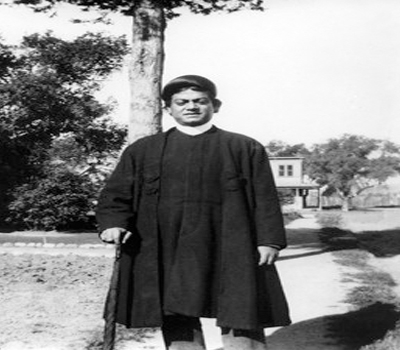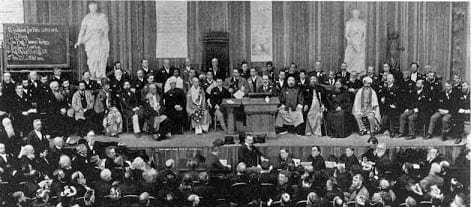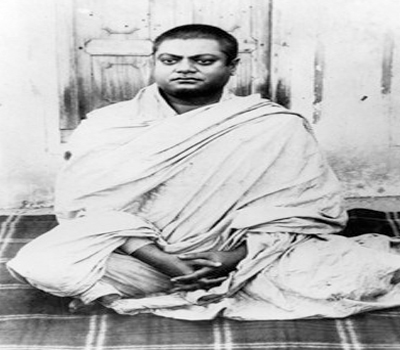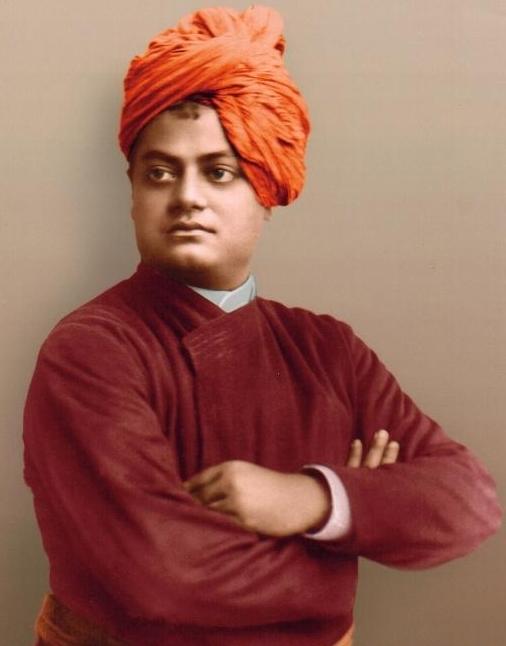The article presents Swami Vivekananda’s meditation at Kanyakumari as his ‘moment of enlightenment’ when his thoughts on the reasons for the downfall of India and the course of its revival took a definite shape.
Introduction
It is true that the World’s Parliament of Religions was a big event in Swamiji’s life that acted as the structural catapult launching him into prominence as Swami Vivekananda—the World Teacher. But that was his ‘external’ nature, an outward manifestation of his inner spiritual power—what people saw and heard. His ‘Buddha moment of enlightenment,’ or just his ‘Buddha moment,’ occurred in two places at Kanyakumari—first in Mother Kumari’s temple and then on what is now known as the Vivekananda Rock. Treating these events as a two-part continuum, this will go down as the most defining moment in his monastic life that elevated him from the level of self-actualization to self-transcendence. It was a totally ‘internal’ phenomenon, an innermost experience. This article attempts to describe what led to that moment, how Swamiji experienced it, and what happened in the aftermath. We know something about what led to it and what happened in the aftermath, but very little about its nature, because Swamiji was rather reticent about what he had experienced over those three days at Kanyakumari; for that, we have to rely on his biographers and our capacity for inductive or deductive imagination.
From the Himalayas to Kanyakumari
It all started in July of 1890 when Swamiji left the Baranagore Math with Swami Akhandananda and started for the Himalayas. His final words before he left was: ‘I shall not return until I acquire such realization that my very touch will transform a man.’1 He returned in January 1897, six and a half years later, to the Alambazar Math (to which the brother disciples had shifted in 1892) after fulfilling his promise; no matter how one looks at it, he transformed generations to come.
He started at the foot of the Himalayas in August 1890, and after going through a myriad of towns, villages, and cities, performing austerities at every chance he got, observing the conditions of people from all walks of life throughout his travels, meeting some with whom he had developed long acquaintances, he finally ended up at Kanyakumari on December 24, 1892.
During those six and a half years that he was outside Calcutta, or even later, he might have had several transcendent moments of deep spiritual experience. But his “Buddha moment” at Kanyakumari tops them all.
What happened at Kanyakumari?
After reaching Kanyakumari, Swamiji went straight to the ‘Mother’s temple’ and fell prostrate in ecstasy before Her image. How long he remained in that position, or how long he sat there in worship, is not known. The Life narrated what happened next as follows:
‘After worshipping the Mother in the temple, it was to this holy rock that the Swami wanted to go for meditation. But how could he go? He had not a single pice for the boatman.
‘Without more ado he plunged into those shark-infested waters and swam across. About him the ocean tossed, but in his mind was greater turbulence.’2
In the first edition of the Life, published in the mid-1910s, the biographers were uncertain about the location of the rock with respect to the temple, and didn’t realize that they were independent of each other. As a result of a visit to Kanyakumari by Swami Virajananda later, that was all corrected and various eye-witness accounts over the years were added to the narrative to make it complete. The above excerpt is from the most recent edition of the Life, published in 1989.
It is natural for the biographers to assume that Swamiji plunged into the ocean because he could not afford a boat ride, but there could have been a more compelling reason why he took to swimming that stretch of water, which was only about 400 meters (two furlongs) wide and could have been even less during a low tide depending on the bottom topography. He was probably in a liminal state, on the verge of transitioning from the real to the ephemeral, looking for answers through meditation in solitude on the rock. He meant to honor that spiritual journey to the rock, ‘sanctified by the blessed feet of the Divine Mother,’ through the hard slog of self-denial to refresh his soul, sharks or no sharks. (The Batuk Bhairavas would have protected him from any kind of danger.*) He probably felt like the resolute pilgrims who think that the arduous journey on foot to ‘Pilgrimage Hinglaj’ is an integral part of their spiritual fulfilment, as important as reaching the destination and offering prayers. The journey has its own unique reward, as it is considered a penance to purify oneself.
The only time Swamiji referred to his visit to Kanyakumari, which is on record, was in a Bengali letter to Swami Ramakrishnananda on March 19, 1894, a little over a year later. That ought to tell us something about his restraint in referring to it. The letter was his first to the brother disciples after leaving Calcutta in July 1890. One noticeable fact is that Swamiji never mentioned the word ‘swim’ in that letter, but there was a subtle hint in it that he did go to the rock. A part of the letter said: ‘In view of all this, specially of the poverty and ignorance, I had no sleep. At Cape Comorin sitting in Mother Kumari’s temple, sitting on the last bit of Indian rock, I hit upon a plan: We are so many sannyasins wandering about, and teaching the people metaphysics—it is all madness. Did not our Gurudeva use to say, “An empty stomach is no good for religion”? That those poor people are leading the life of brutes is simply due to ignorance. We have for all ages been sucking their blood and trampling them underfoot.’3
In the above excerpt, the two significant phrases with a comma in between are: ‘At Cape Comorin sitting in Mother Kumari’s temple, sitting on the last bit of Indian rock.’ These are two separate phrases. Some may think that the second phrase is an appositive for the first, but it is not, because the temple was not built on rock (moreover, the word ‘sitting’ has been used in both).** Swamiji meant that he sat in both places. If he had used a conjunction, and instead written, ‘At Cape Comorin sitting in Mother Kumari’s temple, and sitting on the last bit of Indian rock…,’ that would have made it clearer. But that was not his style; in his Bengali letters, he frequently used commas or other forms of punctuation between phrases—instead of conjunctions.
Meditation at Kanyakumari: transformation to transcendence
Swamiji might not have spent a long time at the temple. Of his three days at Kanyakumari, he spent most of the time on the rock. What he did there wasn’t just ‘hit upon a plan,’ it was much more; and we get some impression of that from the reminiscences of Swami Turiyananda, whom Swamiji met in April/May of 1893 in Western India. About that meeting Turiyanandaji had repeatedly said, ‘I saw Swamiji as a different person, not like the old one, but with new thoughts and expressions.’4 The Life’s account of Turiyanandaji’s statement referring to the meeting was as follows:
‘I vividly remember some remarks made by Swamiji at that time. The exact words and accents, and the deep pathos with which they were uttered, still ring in my ears. He said, “Haribhai, I am still unable to understand anything of your so-called religion.” Then with an expression of deep sorrow on his countenance and intense emotion shaking his body, he placed his hand on his heart and added, “But my heart has expanded very much, and I have learnt to feel. Believe me, I feel intensely indeed.” His voice was choked with feeling; he could say no more. For a time profound silence reigned, and tears rolled down his cheeks.’ In telling of this incident Swami Turiyananda was also overcome. He sat silent for a while, his eyelids heavy with tears. With a deep sigh he said, ‘Can you imagine what passed through my mind on hearing the Swami speak thus? “Are not these”, I thought, “the very words and feelings of Buddha?” . . . I could clearly perceive that the sufferings of humanity were pulsating in the heart of Swamiji: his heart was a huge cauldron in which the sufferings of mankind were being made into a healing balm.’5
The feelings Swami Turiyananda witnessed and recognized were the result of Swamiji’s highly intense spiritual experience at Kanyakumari, which was characterized by such an enhanced state of consciousness, such a profound depth of feeling that it appeared to stand out as his ‘Buddha moment.’ More about this later.
Swamiji was always tight-lipped about his deep spiritual experiences. He had had one such experience in the summer of 1884, when he sank down by the roadside in Calcutta. The logic behind God’s disbursement of justice and mercy became clear to him through that experience, but he never told anybody about the incident except Swami Saradananda; but even then, he didn’t explain exactly how it happened. All he said was ‘By a deep introspection I found the meaning of it all and was satisfied.’6 His Kanyakumari experience was much greater than that, the most significant one in his monastic life, because there he received enlightenment through that long meditation and found the real purpose for his life on earth. His ‘deep introspection’ encompassed three days and three nights.
My heart has expanded very much,
and I have learnt to feel.
Believe me, I feel intensely indeed.
The Life summed it up by saying, ‘Here, then, at Kanyakumari was the culmination of days and months of thought on the problems of the Indian masses; here the longing to find a way by which the wrongs inflicted on them could be righted, was fulfilled.’7 His vision of ‘righting the wrongs’ also emerged as a result of his being a self-actualizer. Self-actualizing people are able to see reality (‘what is’) more clearly, and are quick to perceive ‘what ought to be’ and then develop a plan to go from ‘what is’ to ‘what ought to be.’8 We will come to that later.
Some aspects of what happened to Swamiji during those three days at Kanyakumari would have been described by psychologist Abraham Maslow (1908-1970) as a ‘peak religious experience,’ or just as a ‘peak experience.’ This type of experience, he said, ‘seems to lift us to greater than normal heights so that we can see and perceive in a higher than usual way. We become larger, greater, stronger, bigger, taller people and tend to perceive accordingly…. To say this in a different way, perception in the peak-experiences can be relatively ego-transcending, self-forgetful, egoless, unselfish.’9 Maslow further added, ‘The peak-experiencer becomes more loving and more accepting, and so he becomes more spontaneous and honest and innocent.’
Maslow was an experimentally trained psychologist, and had little formal background in comparative religion with which he could supplement the results of his examinations of people’s various numinous experiences. Swamiji had some discussion about those experiences, like nirvikalpa samadhi, with his friend Professor William James of Harvard. James even quoted Swamiji on the subject of ‘union of the individual with the divine’ in his essay on ‘Mysticism,’ originally published in 1902.10 Maslow was well acquainted with James’ work, but his own work never mentioned such experiences by name.
Characteristically, peak experience leads to a rise in personal awareness and understanding and can serve as a turning point in a person’s life; it generates emotions that are positive and intrinsically rewarding, during which people feel at one with the world with love and compassion abound. Meditation could lead to such peak experiences while the aspirants seek communion with the transcendent. Kanyakumari was where Swamiji made a leap from being a selfactualizer to being a self-transcender.11
The Buddha moment
Siddhartha Gautama sat beneath a tree (known as the Bodhi tree) at Bodh Gaya and meditated. According to some traditions, he attained ‘enlightenment’ in one night; others say three days, or seven days, while still others say 45 days. With his mind purified through concentration, he was supposed to have acquired three kinds of supreme knowledge. In a nutshell, without going into much depth, the first kind was knowledge of his past lives for many thousands of eons. The second was that of the rising and falling of beings, seeing how the laws of karma unfold in detail. The third was knowledge that he was free of all obstacles and released from bondage/attachments.
The ‘peak religious experience’ of Swamiji at the temple and then on the rock at Kanyakumari could have been his combined ‘Buddha moment,’ a state of unitive consciousness. Call it enlightenment, realization, illumination, inspiration, awakening, or whatever—it is immaterial. From what has been documented in the Life, one can draw a parallel between Buddha’s peak experience and that of Swamiji, because the latter also seemed to have acquired three insights as a result. After his enlightenment in one night, the Buddha spent seven days reviewing and consolidating his experience.12 In the same way, Swamiji could have spent three days on the rock reviewing and consolidating his own revelation at the temple earlier. In other words, his Buddha moment might have been a revelation-review consolidation continuum.
First, sitting on the last rock of India, ‘he passed into a deep meditation on the present and future of his country. He sought for the root of her downfall. With the vision of a seer he understood why India had been thrown from the pinnacle of glory to the depths of degradation….The centuries were laid out before him…. Everywhere and at all times he saw that the poor had been oppressed by whatever power the changes of fortune had set over them.’13 To draw an analogy, this is something like Buddha’s first type of knowledge, only it involves the past of a country, not of a person. This was how Swamiji perceived the reality (‘what is’) and how it had manifested itself.
Second, Swamiji ‘saw religion to be the life-blood of India’s millions. “India”, he realized in the silence of his heart, “shall rise only through a renewal and restoration of that highest spiritual consciousness that has made her, at all times, the cradle of the nations and cradle of the Faith”….His soul brooded with tenderness and anguish over India’s poverty.’14 He recalled his Master’s admonition: ‘Religion is not for empty bellies.’ People should first have access to food, shelter, education, healthcare, and the knowledge of science and technology. This he thought was ‘what ought to be.’
Third, to go from ‘what is’ to ‘what ought to be,’ in other words to effect a resolution, he ‘hit upon a plan.’ The nuts and bolts of his plan, at least the essence of it, he first disclosed a little over a year later in the letter to Swami Ramakrishnananda, discussed earlier. Verbalizing Swamiji’s thoughts, the Life said, ‘But what was the remedy? The clear-eyed Swami saw that renunciation and service must be the twin ideals of India. If the national life could be intensified in these channels, everything else would be taken care of.’15
After his enlightenment, Buddha went ahead and founded a new religion that doesn’t even acknowledge God, let alone worship Him. Swamiji, on the other hand, went ahead and professed a new way to worship God. He equated sadhana with seva and exhorted, ‘If you want any good to come, just throw your ceremonials overboard and worship the Living God, the Man-god—every being that wears a human form—god in His universal as well as individual aspect. The universal aspect of God means this world, and worshipping it means serving it.’16
Aftermath of Kanyakumari
Going back in time, Sri Ramakrishna had given Swamiji a mandate, charged him with a complicated mission, of which the latter didn’t have a clear idea, and empowered him to accomplish the work; but the Master provided very little guidance on how to get it done. Swamiji became restless because he wanted to do something, but did not exactly know what to do and how to do it. It probably dawned on him that so far he had been travelling to various holy places , apparently aimlessly, and meeting different people from all walks of life, but had done nothing toward accomplishing his Master’s mission.
If you want any good to come,
just throw your ceremonials
overboard and worship the Living
God, the Man-god — every being
that wears a human form.
All of that changed after his meditation at Kanyakumari. Swamiji decided that instead of going into solitude in the Himalayas to commune with God, he would dedicate his life to the service of India’s outcast, downtrodden, and starving people. He was finally convinced that the God he had taken a vow to serve as a monk, revealed Himself through humanity. His longing for a blissful state of communion with God then became secondary to his overwhelming desire to dedicate his life to the welfare of the Indian people. ‘May I be born again and again,’ he exclaimed, ‘and suffer a thousand miseries, if only I may worship the only God in whom I believe, the sum total of all souls, and above all, my God the wicked, my God the afflicted, my God the poor of all races!’17 Here is how the Life recounted his mental state:
‘He gazed over the waters through a mist of tears. His heart went out to the Master and to the Mother in prayer. From this moment his life was consecrated to the service of India, but particularly to the service of her outcast Narayanas, her starving Narayanas, her millions of oppressed Narayanas. To him, in this hour, even the direct experience of Brahman in the Nirvikalpa Samadhi, and the bliss attending it, became subservient to the overwhelming desire to give himself utterly for the good of the Indian people. His soul was caught up in the vision of Narayana Himself, the Lord of the Universe, transcendent, yet immanent in all beings—whose boundless love makes no distinction between high and low, pure and vile, rich and poor.’18
Itseems that Swamiji’s revelation on the rock reaffirmed his Master’s entire mandate to him more clearly than ever. He then decided to go to America and thus, in a manner of speaking, hit two mangoes with one stone. First, he would fulfill his Master’s prophecy that ‘Naren will teach others’ by expounding to the receptive Americans the ancient wisdom of Indian sages and the sublime concepts of Vedanta. Second, to carry out his Master’s wish that he serve mankind by alleviating their pain and suffering, he would bring back to India from America, in exchange, the knowledge of Western science and technology, as well as some material help, to uplift the condition of the Indian masses. He wanted to weave the best elements of Western civilization into the fabric of Indian thought and culture, and let the West benefit from assimilating Eastern introspection and meditation. To him it was a win-win situation.
Shortly thereafter, Swamiji had a vision as he lay half asleep one night. ‘He saw the figure of his Master, Shri Ramakrishna, walking from the seashore into the waters of the ocean, and beckoning him to follow.’19 He wanted the benediction from the Holy Mother Sri Sarada Devi to go to the West—and he received it. He left for America five months after his “Buddha moment” at Kanyakumari. The rest is history.
References
1) The Life of Swami Vivekananda. [hereafter Life]. Kolkata: Advaita Ashrama, 1989, 1:241
2) Life. 1:340-341
3) The Complete Works of Swami Vivekananda. [hereafter CW]. Mayavati Edition. Kolkata: Advaita Ashrama, 6:254
4) Srimat Vivekananda Swamir Jibaner Ghatanabali. Mahendranath Datta. Kolkata: The Mahendra Publishing Committee, 1998, 3:30
5) Life. 1:388
6) Life. 1:126
7) Life. 1:343
8) Swami Vivekananda: The Ultimate Paradox Manager. [hereafter Manager]. Asim Chaudhuri. Kolkata: Advaita Ashrama, 2016, p.197
9) Religions, Values, and PeakExperiences. A. H. Maslow. New York: Penguin Compass, 1976, pp. 59-68
10) The Varieties of Religious Experience. William James. New York: Barnes & Noble Classics, 2004, pp.346-347
11) Manager. pp.194-197
12) Buddhism in Translations. Henry Clarke Warren. Cambridge: Harvard University Press, 1953, pp. 83-85
13) Life. 1:341
14) Life. 1:341
15) Life. 1:342
16) CW. 6:264
17) Vivekananda: A Biography. Swami Nikhilananda, Kolkata: Advaita Ashrama, 1987, pp.97-98
18) Life. 1:343
19) Life. 1:380
Notes
- There is a story that once Swami Shivananda woke up in the middle of the night at Baranagore Math and saw the space surrounding Swamiji’s sleeping body being lit up due to the presence of miniature Shiva-like images. He woke Swamiji up and told him what he had seen. Swamiji asked him not to bother about that and go to sleep. When he asked him again about it the next morning, Swamiji said, ‘They were Batuk Bhairavas [a child form of Lord Shiva that people invoke for protection against evil spirits], they have been protecting me since my childhood.’(Swami Purnatmananda (Editor), Smritir Aloi Swamiji (Udbodhan Karyalaya, Calcutta, 2009), p. 91.) Shivananda was uniquely privileged to see that because both he and Swamiji were born following their mothers’ special prayers to Lord Shiva.
- According to tradition, the temple was built, maybe a couple of thousand years ago or more, on the rock, which was then a part of the mainland, and now known as the Vivekananda Rock (“the last bit of Indian rock”). The temple was rebuilt on the mainland when sea erosion transformed the rock to an islet. A natural footprint-shaped indent found on the rock is believed to be that of the Devi Herself, and is revered as a symbol of the “Sripadam.” (https://indianmandirs.blogspot.com/2013/11/ sri-kanyakumari-amman-temple.html.) If this is true, and if Swamiji was aware of the compelling Puranic history of the rock where the Divine Mother performed intense austerities as Devi Kanya to win the hand of Lord Shiva, then it explains why he wanted to go there to meditate.
My whole ambition in life is to set in motion a machinery which will bring noble ideas to the door of everybody, and then let men and women settle their own fate. Let them know what our forefathers as well as other nations have thought on the most momentous questions of life.
—Swami Vivekananda
Source : Vedanta Kesari, September, 2019






Leave A Comment